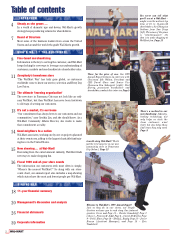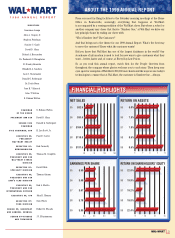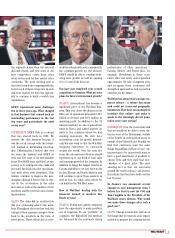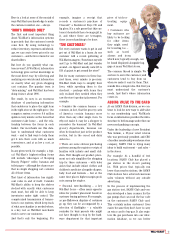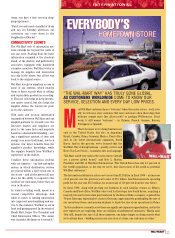Walmart 1999 Annual Report Download - page 6
Download and view the complete annual report
Please find page 6 of the 1999 Walmart annual report below. You can navigate through the pages in the report by either clicking on the pages listed below, or by using the keyword search tool below to find specific information within the annual report.
6
future. We have always moved our best
and brightest talent around the organi-
zation to build the broad skills and expe-
rience that will carry Wal-Mart into the
future. A few years ago we took our CIO,
Bobby Martin, and asked him to run our
International business. Three years ago
we asked Tom Coughlin, who had run
our SAM’S business and was then run-
ning our Specialty Division, to head up
our Wal-Mart store operations. At the
same time Lee Scott moved from
Logistics to lead our Merchandising
team. These are three examples of this
cross-pollination that occurs throughout
our company. The senior management
changes announced in January build on
the extensive experiences that these
individuals have accumulated over the
years and will make our leaders better
prepared to serve our customers and
shareholders in the future.
There has been a great deal of press
regarding your entry into the food
business with your new Neighborhood
Market Stores. Is this the growth plan
of the future?
GLASS: First let me talk a little about
the food business. Over 10 years ago we
began experimenting with a retail con-
cept called a “Hypermarket” or, as our
version was named, a Supercenter. This
concept took the idea of retailing both
general merchandise and food in the
same building and created the conve-
nience of “one-stop shopping.” It has
become our key domestic growth vehicle
and will remain so for at least the next 10
years. This year alone we are going to
open approximately 150 Supercenters in
the United States as well as using it as a
key vehicle in our international growth.
Supercenters effectively serve a large
trade area, but we think there may be
some business that we are not getting
purely because they may not be as close
to the customer or convenient for small
shopping trips. That’s where we think
there may be an opportunity for the
small grocery/drug store format where
we are testing the Neighborhood Market.
Wal-Mart associates are renowned for
getting involved with and taking care
of their communities. Why is this such
a way of life for the Wal-Mart family?
SODERQUIST: You know, Wal-Mart
started in a small town and remains
headquartered in Bentonville,
Arkansas. We understand community
values. In the last year Wal-Mart associ-
ates delivered more than $127 million
dollars to communities and charities in
their home markets. “Home” is really
the key word here! As associates we not
only represent Wal-Mart, we also repre-
sent our local communities and causes,
and by helping those around us we are
helping our friends, neighbors and our
own families. The most amazing thing is
that this mentality permeates the entire
organization from Bentonville to Brazil.
We’ve mentioned that you paid almost
$700 million in shareholder dividends
this year. What else is the company
doing with the tremendous cash flow
that is being generated? Where is the
company investing the shareholders’
money?
GLASS: In addition to the dividends that
were returned directly to the sharehold-
ers, the company spent $3.7 billion
building and remodeling our units
around the world, over $800 million on
acquisitions in Germany and Korea, and
used approximately $1.2 billion for
share repurchase.
The company bought over $1.2 billion
dollars worth of its own stock this
year. Why are you buying your stock
and will this continue in the future?
GLASS: In March, the Board of Directors
increased the share repurchase autho-
rization to $2 billion dollars. Over the
last three or four years the company has
repurchased almost 82,600,000 shares of
the stock on the open market. Share
repurchase programs are a tax-efficient
method of giving back to the sharehold-
ers and one that is frequently used when
companies have very strong cash flow
positions. Share repurchase programs
lower the number of outstanding shares
and therefore increase shareholder
value. However, our first priority for use
of our cash is to build new stores and
clubs throughout our markets. The sec-
ond is acquisitions that make sense for
our company and shareholders and the
third is the share repurchase program.
Internet companies made the news
a lot this year. What is Wal-Mart’s view
toward online retailing and how will
you deal with this new breed of
competitors?
WALTON: Wal-Mart is in the retail busi-
ness and for that reason we look at any
form of retailing as a competitor. The
Internet has some very interesting
aspects and will definitely serve a grow-
ing market as we move into the 21st cen-
tury. However, very few, if any, Internet
retailers have made a profit, and issues
like the cost of delivery, merchandise
returns and data security all have to be
resolved before this business model is
validated. We have been selling from our
Web site for about two years and we will
continue to invest in development and
learning as we move forward. When and
if the business proves viable, we will be
there with the technology, distribution,
assortment and the lowest price. Just
like we are in all of our concepts. We
really look at this business like another
Wal-Mart store, but without walls.
Although Wal-Mart, the company, per-
formed superbly, Wal-Mart stock, did
even better and was up 106% for the
calendar year. In fact, I believe it was
the No. 1 stock on the Dow. Will this
type of appreciation continue?
GLASS: Last year in this annual report I
made the comment that, although it
would be nice, I would not expect the
stock price to appreciate at that 73 per-
cent rate again. Well, I was wrong! Our
associates and customers saw to that.
However, I would again repeat that the
stock appreciation that we have enjoyed
over the last two years is unusual, even
considering the tremendous results and
effort on the part of all of our associates
and partners. Unfortunately, we don’t
directly control the stock market! Our
commitment is to delivering sales and
profits for our shareholders, and allow-
ing the market to take care of itself.
Over time, our earnings growth will con-
trol our share price.


